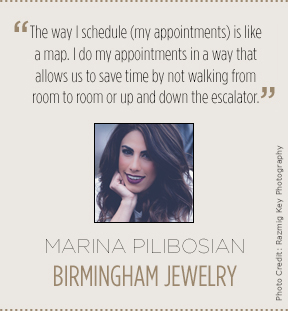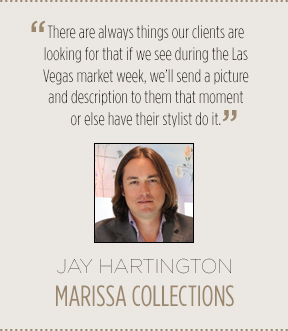





In two weeks, the industry will converge on Sin City, with retailers and brands alike looking to strengthen existing relationships as well as find new business. For retailers, these waning weeks before the show starts are vital to ensuring that they are ready to tackle Las Vegas and get all they can out of market week.
To help stores prepare in their last few days before they head out, National Jeweler asked a few retailers and industry professionals to share what they do beforehand to make sure market week is successful, as well as what they are sure not to forget at home (extra smartphone chargers, business cards.)
National Jeweler talked to Sean Dunn of J.R. Dunn in Lighthouse Point, Fla.; Marina Pilibosian of Birmingham Jewelry in Sterling Heights, Mich.; Jay Hartington of Marissa Collections in Naples, Fla.; and Sherry Smith, business mentor at the The Edge Retail Academy.
![]() Prepare an inventory list. Whether it’s a hard copy that’s been printed out to take along or a digital list that’s kept on a laptop or iPad, having a list of what the store has in one place will be immensely helpful once appointments and meetings start.
Prepare an inventory list. Whether it’s a hard copy that’s been printed out to take along or a digital list that’s kept on a laptop or iPad, having a list of what the store has in one place will be immensely helpful once appointments and meetings start.
“Printing our inventory with style numbers, prices and pictures and organizing it in a way that is quickly and easily accessible during appointments is our key to a successful show,” Pilibosian says, adding that it not only helps them with re-orders from brands they already carry but also when they’re looking for new or trendy pieces to refresh their cases.
![]() Analyze current vendor performance. Dunn suggests doing year-over-year performance evaluations, or at least year-to-date up to show time, looking at whether or not the store’s business with a brand or manufacturer is growing or shrinking.
Analyze current vendor performance. Dunn suggests doing year-over-year performance evaluations, or at least year-to-date up to show time, looking at whether or not the store’s business with a brand or manufacturer is growing or shrinking.
“We’re always looking at our inventory positions, and we have all those by vendor,” Dunn says. “It justifies the inventory that we have by every particular vendor.”
![]() Do research. While retailers need to evaluate current brands and vendors to assess whether or not they should continue to carry them, jewelers also need to know which new companies should be on their radar.
Do research. While retailers need to evaluate current brands and vendors to assess whether or not they should continue to carry them, jewelers also need to know which new companies should be on their radar.
One good way of doing this, Dunn says, is to use Google Trends.
Using the show guides, he recommends going through and searching exhibitor names to see who’s trending positively, indicating that more people know about it or that it has more brand awareness. A brand that has drastically increased in search is someone that should be on a store’s radar, as long as it fits in with the store’s inventory and needs, whereas someone who is trending downward should maybe be avoided.
Smith notes that retailers should do their due diligence when it comes to new lines or new vendors. “Retailers should make sure that they know why they are really considering a new brand,” she says, adding that it’s helpful for time management on the show floor when a retailer has an idea of who should be visited instead of just randomly strolling.
![]() Don’t forget the budget. Pilibosian says that it’s important for them to set budgets before they go—a total budget to start, and then a breakdown of how much the store would like to spend and where it will be spent, including an amount for existing vendors as well as a sum earmarked for new clients and new merchandise.
Don’t forget the budget. Pilibosian says that it’s important for them to set budgets before they go—a total budget to start, and then a breakdown of how much the store would like to spend and where it will be spent, including an amount for existing vendors as well as a sum earmarked for new clients and new merchandise.
Smith also noted the importance of creating an open-to-buy to avoid wandering aimlessly around the show floor. She recommends creating a snapshot of the last few years to establish return on investment and stock levels, especially among a store’s top vendors.
Along the same lines, Smith says that retailers should also show up with a report of the fast-sellers that would be relatively easy to replace while in Las Vegas, as well as give themselves a budget for what they want to spend on new merchandise.
Remember, she says, that buying should be focused on inventory for the next 30 to 90 days, not necessarily for the rest of the year. “You can place orders with ship dates that align with what you may need later this year, but I don’t recommend outright purchasing.”
Smith says retailers also can ask for a hold on a purchase so that when they get back from the trade show, they can take the time to analyze everything they bought and make sure it’s an order that should be completed.
![]() Map out a plan. Though it’s wise to have a mixture of appointments and free time to hit exhibitors that might’ve otherwise been missed, planning a route is key to optimizing time on the show floor, especially when it comes to scheduling appointments.
Map out a plan. Though it’s wise to have a mixture of appointments and free time to hit exhibitors that might’ve otherwise been missed, planning a route is key to optimizing time on the show floor, especially when it comes to scheduling appointments.
“I schedule (all the appointments) by myself, and I create an Excel spreadsheet. The way I schedule them is like a map,” Pilibosian says. “I look at the floor plan and do my appointments in a way that allows us to save time by not walking from room to room or up and down the escalator.”
![]() Create a wish list for clients. Make sure that a list of specific items customers have said they’re looking for has been compiled ahead of time. This way, the store staff can stay on top of it while making the rounds.
Create a wish list for clients. Make sure that a list of specific items customers have said they’re looking for has been compiled ahead of time. This way, the store staff can stay on top of it while making the rounds.
“There are always things our clients are looking for that if we see during the Las Vegas market week, we’ll send a picture and description to them that moment, or else have their stylist do it,” Hartington says.
Dunn stressed the importance of the same—taking along a list of pieces and styles that customers have said they’re looking for—so retailers can be shopping for them while they’re visiting exhibitors. It’ll strengthen relationships with clients as well as their loyalty to the store if they know their jeweler is looking for something special for them.
![]() Keep fashion trends in mind. Dunn says his store always pays attention to the fashion magazines and the trends and looks that are being discussed online, and the store creates a scrapbook and wish list of the pieces they want to see while they’re at market week.
Keep fashion trends in mind. Dunn says his store always pays attention to the fashion magazines and the trends and looks that are being discussed online, and the store creates a scrapbook and wish list of the pieces they want to see while they’re at market week.
Smith says while it is a good idea to keep up with trends and be on the lookout for those special pieces, a retailer also must evaluate whether those specific looks fit with a store’s clientele and overall story.
Make sure, she adds, that new pieces and new brands aren’t competing with any of the store’s existing vendors.
![]() Grab the essentials. Though this is a no-brainer, it bears repeating: Don’t forget those business cards. They’re one of the simplest yet most effective ways to stay top-of-mind with someone and be able to establish connections once the shows are done.
Grab the essentials. Though this is a no-brainer, it bears repeating: Don’t forget those business cards. They’re one of the simplest yet most effective ways to stay top-of-mind with someone and be able to establish connections once the shows are done.
Dunn adds that it’s also a good idea to take an extra outfit that can be worn in the case of an unexpected event invite. “You don’t want to miss the opportunity to establish a new business client or connection if you get the chance,” he says.
![]() Consider your own tools. Pilibosian says she likes to carry her own loupe to the shows, both for sanitary reasons and because she’s already familiar with it so it’s more convenient to use when on the show floor.
Consider your own tools. Pilibosian says she likes to carry her own loupe to the shows, both for sanitary reasons and because she’s already familiar with it so it’s more convenient to use when on the show floor.
Along the same lines, Hartington says it’s always a great reminder to bring extra batteries and chargers for phones and other mobile devices, especially if they’re used to take notes and snap pictures during the shows. ![]()